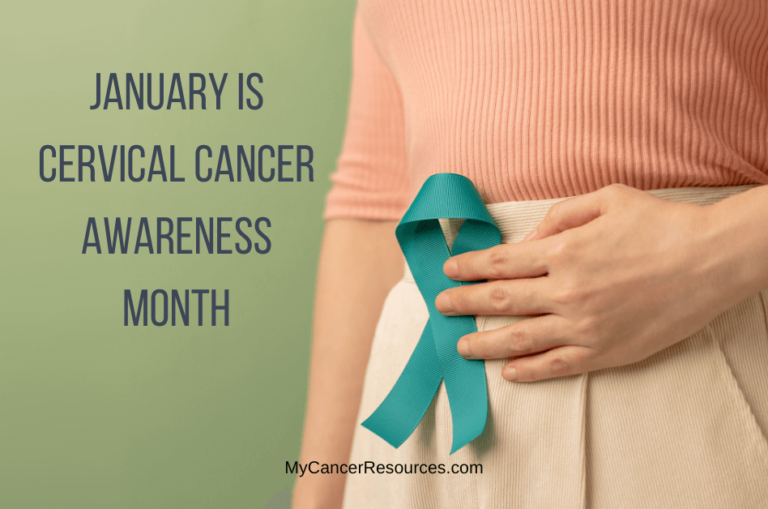
January is Cervical Cancer Awareness Month. Cervical cancer is one of those cancers that is almost 100% curable if it’s caught early. It’s also a type of cancer that shows signs before it develops, which can lead to prevention and early treatment. Let’s learn more about this type of cancer, screening, and treatment.
Understanding the Cervix
The cervix is the entrance to the uterus from the vagina. The cervix has 3 main functions:
- to produce mucus to help sperm travel into the uterus to fertilize an egg
- to protect the uterus from bacteria and other foreign objects and
- to open during labor to let the baby pass through the birth canal
Cervical Cancer Statistics
Cervical cancer used to be a leading cause of cancer death in women in the United States. Since the mid 1970s, incidence and death rates have dropped almost 50%, partially because screening rates improved. Here are some additional statistics about cervical cancer:
- An estimated 13,960 women in the U.S. were diagnosed with invasive cervical cancer in 2023, and there were an estimate 4,310 deaths in 2023 from cervical cancer in the United States.
- Cervical cancer is typically diagnosed between 35 and 44.
- Cervical cancer affects different ethnic groups differently, with less successful treatment for non-whites. The death rate is 65% higher in Black women than in White women in the U.S., even when similar levels of routine screenings are reported. Hispanic women in the United States are 30% more likely to die from cervical cancer than White women as well.
- Cervical cancer is the 4th most common cancer in women worldwide. In 2020, there was an estimated 604,000 new cases of cervical cancer and 342,000 cervical cancer deaths around the world.
- The highest rates of cervical cancer are in low and middle-income countries, partially due to lack of access to screening, cancer treatment, and vaccinations and also the stigma around sexual health.
Early Detection is Critical
The main cause of cervical cancer (an estimated 99%) is infection with high risk human papillomavirus virus (HPV). HPV is a very common virus that is transmitted through sexual contact.
Although most infections with HPV resolve on their own and cause no symptoms, if one’s body does not clear the infection on its own, it can lead to a chronic, persistent infection. This ongoing infection can lead to cervical cancer.
HPV doesn’t just lead to cervical cancer. Other HPV-related cancers include anal cancer, penile cancer, vaginal cancer, vulvar cancer and oropharyngeal (mouth and throat cancer).
The good news is that if caught early, cervical cancer has an almost 100% cure rate. This is why cervical screening is so important.
Cervical cancer typically develops slowly over time. Before cancer appears, the cells of the cervix begin to change. These abnormal cells start to appear in cervical tissue; these precancerous changes is called dysplasia. These abnormal cells can develop into cancer cells that grow and spread into the cervix and surrounding tissue.
The Greek scientist Georgios Papanicolaou was an early pioneer in cancer detection methods. Back in 1920, he realized that the difference between normal and cancerous cervical cells were visible on a slide under a microscope.
In 1928, he released his low-cost, easily performed screening test to detect cancerous and precancerous cells, which is now known as the Pap test or Pap smear.
There is also an HPV test which can be done at the same time as a Pap test, often as part of pelvic exams.
This test screens for the most high risk hpv types, the ones that have the highest risk of cervical cancer developing, if the body doesn’t get rid of the infection on its own and an ongoing infection is left untreated.
If both Pap and HPV tests are negative, healthcare providers often say that no additional tests are needed for another five years, unless symptoms occur.
It’s recommended that Pap tests begin at 21 years of age. For those over 65, if you’ve had regular screening tests and:
- no hpv disease has been noted,
- each pap test result over the last several years has been negative,
- there have never been any signs of dysplasia, or
- if your cervix has been removed as part of a total hysterectomy for non-cancerous reasons, like fibroids,
your doctor may say that you don’t need to be screened any longer.
It is rare that cervical cancer is diagnosed after age 65. But if you do have any of the signs or symptoms, or just feel like something is off, then call your doctor for an exam.
HPV Vaccine
The HPV vaccine has been around for a number of years. It was designed to protect against the types of HPV that most often lead to cervical (and other) cancer.
The vaccine is for preteens, in hopes it will protect against human papilloma virus before sexual activity begins. The vaccine is not recommended for anyone over the age of 26.
HPV vaccination prevents new HPV infections, but doesn’t treat existing infections.
Even if the HPV vaccination was received, regular cervical cancer screening is necessary.
Signs and Symptoms of Cervical Cancer
Early stages of cervical cancer may not have any signs or symptoms. As cervical cancer progresses, signs may become more evident.
Reach out to your doctor if you experience the following:
- unusual bleeding between periods, after menopause, or after sexual intercourse
- increased or foul-smelling vaginal discharge
- persistent pain in the back, legs, or pelvis
- weight loss, fatigue and loss of appetite
- vaginal discomfort or
- swelling in the legs
Cervical Cancer Treatment
Precancerous cells, the dysplasia that was mentioned earlier can be treated through heat to burn off abnormal cells, freezing the abnormal cells, or by cutting out the damaged cells.
I have had precancerous cells removed and it was slightly uncomfortable, not any worse than the collection of cells for the pap smear. So don’t avoid or put off screening due to fear of pain or discomfort.
If cervical cancer is found, it can be treated with surgery, radiation, chemotherapy, or immunotherapy. Surgery can include a simple or radical hysterectomy.
Sometimes both radiation and chemo are given at the same time (versus completing all radiation treatments first, then starting chemo).
Conclusion
The best scenario is to discover abnormal cells through appropriate screening and treat those abnormal cells, before it becomes a cervical cancer diagnosis. This article has pointed out the importance of early detection.
But even if cancer of the cells spreads, this is a cancer that is often very responsive to treatment. The likelihood of successful treatment increases if the cancer is caught early.
So get HPV testing too during your next pap test and pelvic exam. The start of a new year, cervical cancer awareness month is a perfect opportunity to get the testing done and make sure you’re healthy. If any cell changes are found, they can be treated right away.
Encourage your friends and family members to get screened too. Many organizations will offer a free or low cost cervical cancer screening program so that cost isn’t a barrier to getting screened. Call your local public health department to see if any of these programs are available in your area.
References:
https://www.cancer.net/cancer-types/cervical-cancer/statistics
https://www.who.int/news-room/fact-sheets/detail/cervical-cancer#:~:text=Key%20facts,%2D%20and%20middle%2Dincome%20countries.



